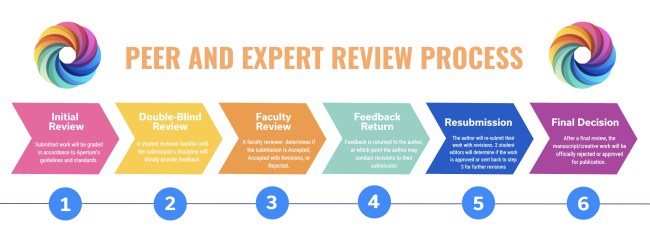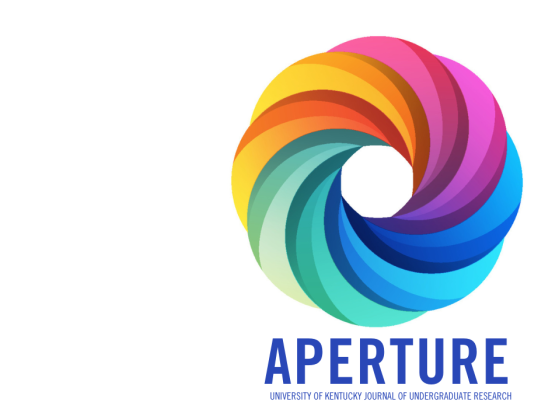

Aperture Review Process
IMPORTANT DATES
Student Committee Application Portal Opens: Now Open!
Student Committee Application Deadline: September 19, 2025
Journal Submission Portal Opens: October 16, 2025
Journal Submission Deadline: January 23, 2026
View Submission Guidelines
SUBMIT YOUR WORK
Student Submission Form
Peer and Expert Review Process
Step 1: Initial Copy-Editing Review (Desk-Review)
The Desk-Review process will be completed by student copy editors in the Publication/Production Committee. Copy editors will be in charge of checking for grammar, citations, and organization of the submission. All corrections will be sent back to the author with a one-week correction period before being sent to the editorial review committee and faculty reviewer. Copy editors will assign the author a submission ID number which will be used when sending information to the student editorial review committee and faculty reviewer.
After the completion of the copy-editing review process, the student copy editor in charge of the submission will be in charge of facilitating the double-blind review process for the editorial review committee and faculty committee. All names, affiliations, and any identifying information of both authors and editorial review committee and faculty reviewer will remain anonymous to ensure an unbiased review.
Step 2: Student Peer Review (Editorial Review)
After the submission passes the Desk-Review stage, the manuscript/creative work will be passed on to the double-blind review process. Here, editorial committee reviewers familiar with the discipline the submission falls under will provide further feedback, guidance, and revisions if necessary.
Based on the criteria derived from the submission guidelines, the aims of Aperture, and general journal standards of writing, 3 student editors will determine if the submission is likely to survive the faculty double-blind review process.
If the submission is not up to standards based on this criterion, the editorial team may provide the author with constructive feedback on how to revise the submission to fit Aperture’s standards.
The copy editors will send feedback from the editorial team to the author(s) to maintain the double-blind review process. The author has two weeks from the time the feedback is sent to them to make the corrections and resubmit to their designated copy editor.
During this two-week correction period, the editorial committee student editors will contact an appropriate faculty member within the discipline of the submission to proceed with the next stage of the double-blind review process.
If the submission fails to pass the student peer review process 2 times, it will no longer be considered for publication.
Step 3: Faculty Double-Blind Review Process
There will be only one faculty reviewer for each submission, as this is primarily a student-run journal intended to serve as a conduit for enhancing the journal writing skills of student scholars.
The faculty reviewer may completely reject a submission based on inaccurate analyses, misinformation, or other fundamental errors the manuscript/creative work will be unable to resolve.
If there are no fundamental problems, the faculty reviewer will provide either major, minor, or no revisions needed.
At this stage, there are three categories the submission may fall under: Accepted, Accepted with Revisions, and Rejected.
Step 4: Returning of Faculty Reviewer Feedback
Feedback provided by the faculty reviewer will be returned to the author via the student copy editor, at which point the author may conduct revisions to their submission. Further questions may be answered by the student copy editor, who will be able to communicate with the faculty or editorial committee reviewer while maintaining the integrity of the double-blind review process.
The author will have two weeks from when feedback is sent to them from the student copy editor to make the revisions needed and resubmit to the student copy editor.
Step 5: Re-Submission
The author will re-submit the manuscript/creative work with revisions. At this stage, 2 editorial committee student editors will review the submission to determine if it upholds the journal’s criteria for publication and has addressed the feedback provided by the faculty reviewer. The submissions may also be sent back to the faculty reviewer to further ensure a successful revision if there are any discrepancies with the corrections of the submission.
At most, the author may re-submit the manuscript/creative work twice after the faculty reviewer process.
At this stage, the student editors will determine if the submission has been: Accepted or Rejected.
Step 6: Accepted for Publication or Rejected
After acceptance of the manuscript/creative work, a final version of the manuscript/creative work as it will appear in the journal will be sent to the author for approval to publish. After a final review and confirmation from the author, the manuscript/creative work will be officially approved and ready for publication.
If the manuscript/creative work is not accepted for publication, it will be returned to the author.
